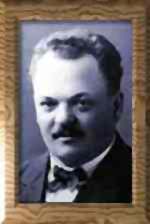I forgot to zip my pant
How many times have we forgotten to zip our pant. Alas, Umpteen times. Today I did forget. There are times when I felt handsome/smart in early wee hours as people stared at me, only to realize later that I forgot to zip my pant.
As I analyze to what could be the most common activity in our day to day life, I was surprised to find that one item among them is listed in the top 100 inventions till date.
Any Guesses? Have I read your mind rightly? You must be thinking about an item related to eating, sleeping, working etc. But hey, you might have missed one thing? Did you zip your pant? Please check again before you start reading this article else someone might stare at you like they did for me. Yes, i am talking about the zipper.
Well today, as i was browsing through Top 100 inventions of the world, the one I found one truly interesting is the invention of "ZIP" or "ZIPPER". I dedicate this article to
Royal Mechanical engineers being one among them.
Invention of ZIP/ZIPPER today is considered to be one of the greatest invention. Why? Probably because of its simplicity, usage and its impact in our daily lives.
Now let me question myself - "How many times do I deal with zip daily?". Astonishingly around 23 times. Much more than the no of times i eat or drink tea. yet I do not remember or appreciate it.
How 23!
Time: 7.00 AM: To the Loo : Zip Usage->2 (Unzip and Zip)
Time: 8.45 AM: To Office-> Wear Trousers: Zip Usage->1 (Zip)
Time: 8.50 AM: To Office-> Laptop pack: Zip Usage->1 (Zip)
Time: 9.00 AM: Reach Office-> Laptop unpack: Zip Usage->2 (Unzip and Zip)
Time: 9.05 AM: In Office-> To the Loo: Zip Usage->2 (Unzip and Zip)
Time: 11.0 AM: In Office-> To the Loo: Zip Usage->2 (Unzip and Zip)
Time: 1.00 PM: In Office-> To the Loo: Zip Usage->2 (Unzip and Zip)
Time: 4.00 PM: In Office-> To the Loo: Zip Usage->2 (Unzip and Zip)
Time: 7.00 AM: Leave Office-> Laptop pack: Zip Usage->2 (Unzip and Zip)
Time: 8.05 AM: Reach Home-> Remove Trousers: Zip Usage->1 (Unzip)
Time: 8.10 AM: Reach Home-> Laptop Unpack: Zip Usage->1 (Unzip)
Let us add some buffer: 5
Is it the same for you too....{do comment if there is some additions or deletions in the count}
Surprisingly, all have atleast one item with them all through the day that has a zip. Great isn't it!
History
Now that we have realized the importance of it, let us go back to history and salute the men who did the invention.
Mr Whitcomb Judson (who also invented 'Pneumatic Street Railway') is know as the inventor of zipper. Zipper was invented in 1893 and was originally called as
'Clasp Locker'. The Chicago inventor's 'Clasp Locker' was a complicated hook-and-eye shoe fastener. Together with businessman Colonel Lewis Walker, Whitcomb launched the Universal Fastener Company to manufacture the new device. The clasp locker had its public debut at the 1893 Chicago World's Fair and met with little commercial success.
Swedish-born (who later immigrated to Canada), Gideon Sundback, an electrical engineer, was hired to work for the Universal Fastener Company. Good design skills and a marriage to the plant-manager's daughter Elvira Aronson led Sundback to the position of head designer at Universal. He was responsible for improving the far from perfect 'Judson C-curity Fastener.' Unfortunately, Sundback's wife died in 1911. The grieving husband busied himself at the design table and by December of 1913, he had designed the modern zipper.
Gideon Sundback increased the number of fastening elements from four per inch to ten or eleven, had two facing-rows of teeth that pulled into a single piece by the slider, and increased the opening for the teeth guided by the slider. The patent for the 'Separable Fastener' was issued in 1917. Sundback also created the manufacturing machine for the new zipper. The 'S-L' or scrapless machine took a special Y-shaped wire and cut scoops from it, then punched the scoop dimple and nib, and clamped each scoop on a cloth tape to produce a continuous zipper chain. Within the first year of operation, Sundback's zipper-making machinery was producing a few hundred feet of fastener per day.
The popular 'zipper' name came from the B. F. Goodrich Company, when they decided to use Gideon's fastener on a new type of rubber boots or galoshes and renamed the device the zipper, the name that lasted. Boots and tobacco pouches with a zippered closure were the two chief uses of the zipper during its early years. It took twenty more years to convince the fashion industry to seriously promote the novel closure on garments.
The zipper beat the button in the 1937 in the "Battle of the Fly," when French fashion designers raved over zippers in men's trousers. Esquire magazine declared the zipper the "Newest Tailoring Idea for Men" and among the zippered fly's many virtues was that it would exclude "The Possibility of Unintentional and Embarrassing Disarray." Obviously, the new zippered trouser owners had not yet discovered the experience of forgetting to zip-up.
The next big boost for the zipper came when zippers could open on both ends, as on jackets. Today the zipper is everywhere, in clothing, luggage and leather goods and countless other objects. Thousands of zipper miles produced daily, meet the needs of consumers, thanks to the early efforts of the many famous zipper inventors.
Production
Any bet on which country tops zipper production: China and Japan tops the chart along with Bangladesh, India and Pakistan
Links





































.jpg)





